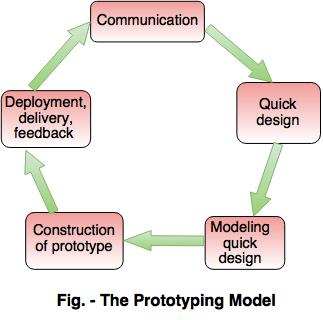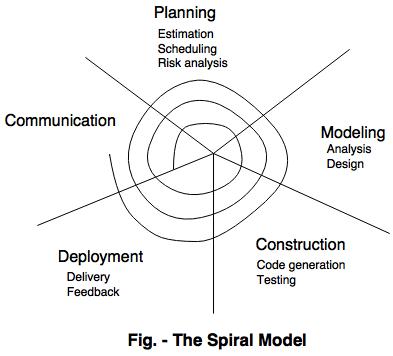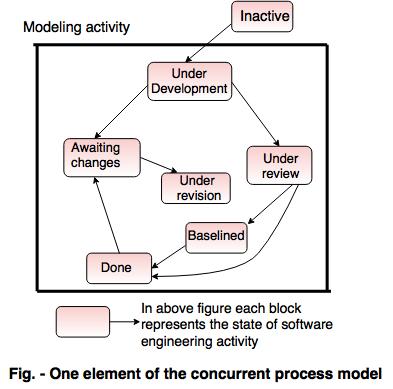Evolutionary Process Models in Software Engineering
Evolutionary Process Models
- Evolutionary models are iterative type models.
- They allow to develop more complete versions of the software.
Following are the evolutionary process models.
1. The prototyping model
2. The spiral model
3. Concurrent development model
1. The Prototyping model
- Prototype is defined as first or preliminary form using which other forms are copied or derived.
- Prototype model is a set of general objectives for software.
- It does not identify the requirements like detailed input, output.
- It is software working model of limited functionality.
- In this model, working programs are quickly produced.
 The different phases of Prototyping model are:
1. Communication
The different phases of Prototyping model are:
1. Communication
In this phase, developer and customer meet and discuss the overall objectives of the software.
2. Quick design- Quick design is implemented when requirements are known.
- It includes only the important aspects like input and output format of the software.
- It focuses on those aspects which are visible to the user rather than the detailed plan.
- It helps to construct a prototype.
3. Modeling quick design- This phase gives the clear idea about the development of software because the software is now built.
- It allows the developer to better understand the exact requirements.
4. Construction of prototype
The prototype is evaluated by the customer itself.
5. Deployment, delivery, feedback- If the user is not satisfied with current prototype then it refines according to the requirements of the user.
- The process of refining the prototype is repeated until all the requirements of users are met.
- When the users are satisfied with the developed prototype then the system is developed on the basis of final prototype.
Advantages of Prototyping Model- Prototype model need not know the detailed input, output, processes, adaptability of operating system and full machine interaction.
- In the development process of this model users are actively involved.
- The development process is the best platform to understand the system by the user.
- Errors are detected much earlier.
- Gives quick user feedback for better solutions.
- It identifies the missing functionality easily. It also identifies the confusing or difficult functions.
Disadvantages of Prototyping Model:- The client involvement is more and it is not always considered by the developer.
- It is a slow process because it takes more time for development.
- Many changes can disturb the rhythm of the development team.
- It is a thrown away prototype when the users are confused with it.
2. The Spiral model
- Spiral model is a risk driven process model.
- It is used for generating the software projects.
- In spiral model, an alternate solution is provided if the risk is found in the risk analysis, then alternate solutions are suggested and implemented.
- It is a combination of prototype and sequential model or waterfall model.
- In one iteration all activities are done, for large project's the output is small.
The framework activities of the spiral model are as shown in the following figure.
 NOTE:
NOTE: The description of the phases of the spiral model is same as that of the process model.
Advantages of Spiral Model- It reduces high amount of risk.
- It is good for large and critical projects.
- It gives strong approval and documentation control.
- In spiral model, the software is produced early in the life cycle process.
Disadvantages of Spiral Model- It can be costly to develop a software model.
- It is not used for small projects.
3. The concurrent development model
- The concurrent development model is called as concurrent model.
- The communication activity has completed in the first iteration and exits in the awaiting changes state.
- The modeling activity completed its initial communication and then go to the underdevelopment state.
- If the customer specifies the change in the requirement, then the modeling activity moves from the under development state into the awaiting change state.
- The concurrent process model activities moving from one state to another state.
 Advantages of the concurrent development model
Advantages of the concurrent development model- This model is applicable to all types of software development processes.
- It is easy for understanding and use.
- It gives immediate feedback from testing.
- It provides an accurate picture of the current state of a project.
Disadvantages of the concurrent development model- It needs better communication between the team members. This may not be achieved all the time.
- It requires to remember the status of the different activities.


